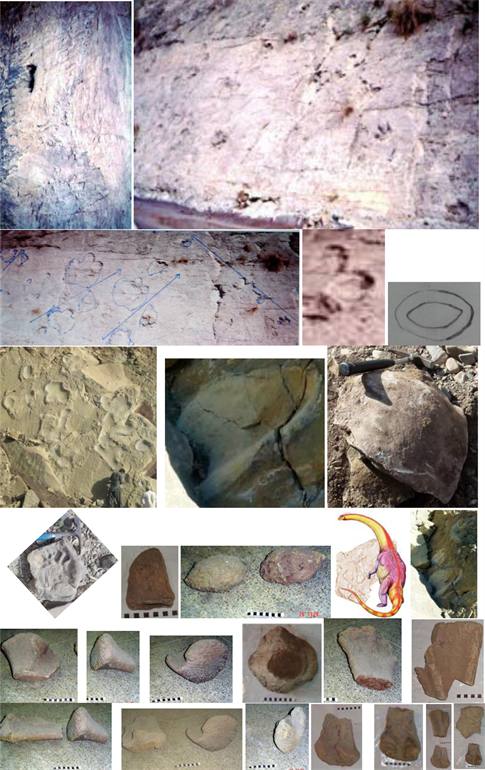Post by Life on Mar 14, 2021 5:25:57 GMT 5
 [1]
[1]Illustration by Asim Mirza
Classification
| Kingdom | Animalia | ||
| Phylum | Chordata | ||
| Clade | Dinosauria; Saurischia; Theropoda | [2] | |
| Family | Ceratosauridae | [2] | |
| Genus | Samanadrinda | [2] | Malkani (2007) |
| Species | Samanadrinda surghari | [2] | Malkani (2007) |
| Age | 175.6 - 161.2 Ma | [2] |
Naming considerations
The name, Samana, is the geological formation of the site, Drinda means beast in Urdu and Saraiki language while Surghari is dedicated to the name of Surghar range which hosts the area [1]; Middle Jurassic Sammana Suk Formation in short [3].
Size
Sheer size of the footprints of S. surghari indicate a gigantic theropod approaching 10 - 12 m in TL:
The Samanadrinda surghari [27] [28] large theropod trackway including 5 footprints in a single trackway (Figure 7) confronted by a herd of Malakhelisaurus mianwali titanosauriforms (early titanosaurs or may be ornithischian) were found from the Late Jurassic (150 - 145 Ma) upper successions of Samanasuk Limestone of Baroch Nala, Malakhel area, Mianwali District, Punjab. Limestone dips 52˚ west and strike north 50˚ east. The trackway pace and stride and straight alignment of pes print reveal a running large bodied theropod attacked obliquely on a herd of Malakhelisaurus mianwali. This site reveals the very large theropod moved and attacked as solitary. The measurement of the first preserved left footprint shows following analysis. Very Large (72 cm long; 60 cm broad) tridactyl footprint have digit length ratios III/II = 1.45 and III/IV = 1.1, respectively. The length to width ratio is about 1.2. Phalangeal pads visible in digit II are two, in digit III are three, and in digit IV are four. Toes thick, sharply tapered, digit III is slightly larger than digit IV, while digit III is considerably larger than digit II. It means digit III and digit IV are subequal. Divarication angle of digits II-IV is 50˚. On comparison with [32] data, the Samanadrinda surghari footprints characters and ratios are different. Samanadrinda may be an ancestor of ceratosaur abelisauroids while Himalayadrinda is the ancestor of noasaurids. Samanadrinda surghari divarication angle about 50˚ are close to Anomoepus sp. The footprints of Samanadrinda from Pakistan are larger than giant theropod footprint from the Early Jurassic of Poland [33] and also larger than Indian theropod footprints [34]. Applying [35] revised formula of H= 4.586 L, the height upto hip is 3.3 m and applying [36] formula H = 4W, the height become 2.4 m. In average height is 2.85 m. It belongs to a biped that has over 2.5 m height at the hip and 10 - 12 m long. Footprints formation process is as follows. The theropod stepped on a thick cohesive calcareous mud layer, its foot sinking to the top part of an underlying calcareous mud layer, producing a negative relief. The calcareous mud was squeezed out sidewise. Later clayey mud layer filled the footprints depression and other succession continued. Diagenesis turned the calcareous mud into limestone and the mud layer into shale. Shale and upper sequences eroded after tectonic uplift. The footprints on hard beds remained preserved and exposed after erosion of upper beds by tectonic uplift which tilted host bed more than 50˚. - [4]
Prey considerations
 [1]
[1]S. surghari preyed upon titanosaurid identified as Malakhelisaurus mianwali [1][3].
Additional shots
 [3]
[3] [4]
[4]REFERENCES
[1] www.dawn.com/news/617762/rare-dinosaur-footprints-in-pakistan
[2] www.fossilworks.org/cgi-bin/bridge.pl?a=taxonInfo&taxon_no=120845
[3] Malkani, M. S. (2007). Trackways evidence of sauropod dinosaurs confronted by a theropod found from Middle Jurassic Samana Suk Limestone of Pakistan. Sindh University Research Journal (Science Series), 39(1), 1-14.
[4] Malkani, M. S. (2019). Recently Discovered Basilosaurid, Baluchithere Rhinoceros, Horses, Sea Cow, Proboscidean, Eucrocodile, Pterosaurs, Plesiosaur, Fishes, Invertebrates and Wood Fossils, Tracks and Trackways of Dinosaurs from Pakistan; Comparison of Recognized Four Titanosaur Taxa of Indo-Pakistan with Madagascar. Open Journal of Geology, 9(12), 919-955.

